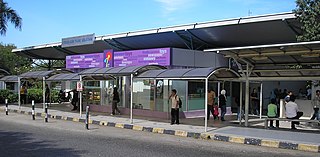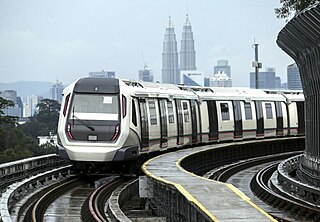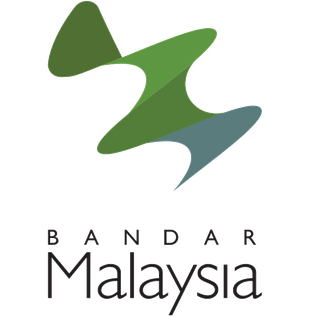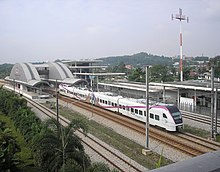
Putrajaya, officially the Federal Territory of Putrajaya, is the administrative and judicial capital of Malaysia. The seat of the federal government of Malaysia was moved in 1999 from Kuala Lumpur to Putrajaya because of overcrowding and congestion in Kuala Lumpur, whilst the seat of the judiciary of Malaysia was later moved to Putrajaya in 2003. Kuala Lumpur remains as Malaysia's national capital city per the constitution and is still the seat of the head of state and the national legislature, as well as being the country's commercial and financial centre.

Kuala Lumpur International Airport (KLIA) is Malaysia's main international airport. It is located in the Sepang District of Selangor, approximately 45 kilometres (28 mi) south of Kuala Lumpur and serves the city's greater conurbation.

The ERL KLIA Ekspres is an express airport rail link servicing the Kuala Lumpur International Airport (KLIA) in Malaysia. It runs from KL Sentral, the main railway station of Kuala Lumpur to KLIA as well as its low-cost terminal, klia2. The line is one of the two services on the Express Rail Link (ERL) system, sharing the same tracks as the KLIA Transit. The KLIA Transit stops at all stations along the line, whereas the KLIA Ekspres runs as a direct non-stop express service between KL Sentral and KLIA/klia2. It is operated by Express Rail Link Sdn. Bhd. (ERL).

Kuala Lumpur Sentral Station is a transit-oriented development that houses the main railway station of Kuala Lumpur, the capital of Malaysia. Opened on 16 April 2001, KL Sentral replaced the old Kuala Lumpur railway station as the city's main intercity railway station. KL Sentral is the largest railway station in Malaysia, and also in Southeast Asia from 2001 to 2021, before Krung Thep Aphiwat Central Terminal in Bangkok, Thailand was completed.

The Sepang District is a district located in the southern part of the state of Selangor in Malaysia. Sepang District covers an area of around 600 square kilometres, and had a population of 190,889 in the 2010 Census.

The ERL KLIA Transit is a commuter rail service which serves as an airport rail link to the Kuala Lumpur International Airport (KLIA) in Malaysia. It runs from KL Sentral, the main railway station of Kuala Lumpur to KLIA Terminal 1 and KLIA Terminal 2. The line is one of the two services on the Express Rail Link (ERL) system, sharing the same tracks as the KLIA Ekspres. KLIA Transit stops at all stations along the line, whereas KLIA Ekspres runs an express, non-stop service between KL Sentral and the airport. The ERL is operated by Express Rail Link Sdn. Bhd. (ERL).

Bandar Tasik Selatan is a township in Sungai Besi, Kuala Lumpur, Malaysia. It was established in 1991.

Salak Tinggi is a town in Sepang District, Selangor, Malaysia. Located about 9 km north of the Kuala Lumpur International Airport, it is the seat of the Sepang district's administration.

Rail transport in Malaysia consists of heavy rail, light rapid transit (LRT), mass rapid transit (MRT), monorails, airport rail links and a funicular railway line. Heavy rail is mostly used for intercity services and freight transport as well as some urban public transport, while rapid transit rails are used for intracity urban public transport in the capital city of Kuala Lumpur and the surrounding Klang Valley region. There are two airport rail link systems linking Kuala Lumpur with the Kuala Lumpur International Airport and Sultan Abdul Aziz Shah Airport. The longest monorail line in the country is also used for public transport in Kuala Lumpur, while the only funicular railway line is available in Penang.

Bandar Tasik Selatan station (BTS) is a major Malaysian interchange station located next to and named after Bandar Tasik Selatan, in Kuala Lumpur. The station serves as both a stop and an interchange for the KTM Komuter's Seremban Line, KTM ETS, the LRT Sri Petaling Line, and the Express Rail Link's KLIA Transit trains. BTS is integrated with the Terminal Bersepadu Selatan bus hub (TBS). BTS and TBS are developed as an intermodal transportation hub.
Transport in Greater Kuala Lumpur includes a road network, a railway network, airports, and other modes of public transport. Greater Kuala Lumpur is conterminous with the Klang Valley, an urban conglomeration consisting of the city of Kuala Lumpur, as well as surrounding towns and cities in the state of Selangor. The Klang Valley has the country's largest airport, the Kuala Lumpur International Airport (KLIA), as well as the country's largest intermodal transport hub and railway station, Kuala Lumpur Sentral.

The KLIA Terminal 1 ERL station is a station on the Express Rail Link (ERL) which serves the Terminal 1 building of Kuala Lumpur International Airport (KLIA) in Sepang, Selangor, Malaysia. The station is located on the first floor of the building. It is served by both lines of the ERL, the KLIA Ekspres and KLIA Transit.

Putrajaya Sentral is a bus hub and a train station on the Express Rail Link (ERL) in Presint 7, Putrajaya, Malaysia. It is served by the ERL KLIA Transit Line under the name Putrajaya & Cyberjaya. On 16 March 2023, the MRT Putrajaya Line began operations under the name Putrajaya Sentral.
The operations and infrastructure of Kuala Lumpur International Airport reflect its design.

KLIA Terminal 2 ERL station is a station on the Express Rail Link (ERL) which serves Terminal 2, the low-cost carrier terminal at Kuala Lumpur International Airport (KLIA), Malaysia. The second ERL station to serve the airport, it began operations on 1 May 2014 in conjunction with the opening of Terminal 2. The station is located on Level 2 at the Gateway@klia2 complex. It is served by both lines of the ERL, KLIA Ekspres and KLIA Transit.

The Klang Valley Integrated Transit System is an integrated transport network that primarily serves the area of Klang Valley and Greater Kuala Lumpur. The system commenced operations in August 1995 with the introduction of commuter rail service on the existing rail between Kuala Lumpur and Rawang. The system have since expanded and currently consists of 11 fully operating rail lines in a radial formation; two commuter rail lines, six rapid transit lines, one bus rapid transit line and two airport rail links to the Kuala Lumpur International Airport's (KLIA) Terminal 1 and Terminal 2, and one temperarily suspended airport rail link to the Sultan Abdul Aziz Shah Airport. The system encompasses 528.4 kilometres (328.3 mi) of grade-separated route on standard gauge and metre gauge with 197 operational stations.

Bandar Malaysia is a 486-acre mixed-use, transit-oriented development by 1Malaysia Development Berhad (1MDB) located in Kuala Lumpur, Malaysia. This project will be built at the current Sungai Besi Air Base site over 20 years. It is planned as a central transport hub connecting high-speed rail to Singapore, Mass Rapid Transit, KTM Komuter, Express Rail Link, and 12 other highways with an estimated gross development value (GDV) of over RM140 billion. Bandar Malaysia was slated to be a hub for global multinationals and Fortune Global 500 companies, and has the opportunity to become a game-changer for foreign investors in Malaysia. The project was ready to start by early 2021, after the settlement of a RM1.24bil payment to the Federal Government by IWH-CREC but was pushed back to a later date.
The Bandar Malaysia railway station is a planned railway station and a high-speed rail terminus as part of the Bandar Malaysia project in the Salak Selatan district in southern Kuala Lumpur, Malaysia.

The KTM KL Sentral–Terminal Skypark Line is a currently suspended limited express train service in Kuala Lumpur, Malaysia between Kuala Lumpur Sentral and Sultan Abdul Aziz Shah Airport. It is Malaysia's second airport rail link service, after the Express Rail Link system.



























